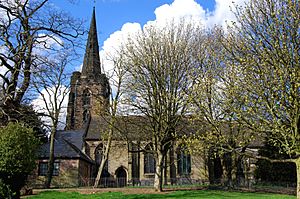St Werburgh's Church, Spondon facts for kids
Quick facts for kids The Parish Church of St Werburgh, Spondon |
|
|---|---|
 |
|
| 52°55′09″N 1°24′35″W / 52.91915°N 1.40977°W | |
| Country | England |
| Denomination | Church of England |
| Churchmanship | Inclusive Anglo-Catholic |
| Website | www.stwerburgh.com |
| History | |
| Dedication | St. Werburgh |
| Architecture | |
| Heritage designation | Grade II listed building |
| Architectural type | Gothic |
| Completed | 1390 |
| Specifications | |
| Spire height | 35 metres (115 ft) |
| Administration | |
| Parish | Spondon |
| Diocese | Diocese of Derby |
| Province | Canterbury |
St. Werburgh's Church in Spondon, Derbyshire, is a historic church. It belongs to the Church of England and follows a special tradition called Anglo-Catholic. This means it has some practices similar to older church styles.
Contents
Exploring St. Werburgh's Church, Spondon
A Look at the Church's Past
The church you see today was built around the year 1390. It replaced an older church that was sadly destroyed by fire in 1340. In 2012, it was officially recognized as a Grade II listed building. This means it's an important historical site.
The main parts of the church, like the nave (where people sit) and the chancel (near the altar), are from 1390. The tall tower and spire, which is about 35 meters (115 feet) high, also date back to this time. However, the north wall of the nave had to be rebuilt in 1826 because the ground shifted.
In 1892, the church underwent a big renovation. Many changes made in 1826 were reversed. For example, the flat roof was replaced with a sloped one. Other roofs were also made taller. The north aisle (a side section) was rebuilt, and its outer wall was moved out by 5 feet. Plaster was removed from the walls and pillars to show the original stone underneath. The arch under the tower was opened up, and any upper seating areas were taken out. The architect for this work was John Oldrid Scott from London.
Recently, the tower and spire have had major repairs. These repairs were partly paid for by the Heritage Lottery Fund. Recent projects have focused on restoring the floor of the nave. They also aimed to improve welcome facilities and rearrange the sanctuary by adding a permanent altar in front of the choir stalls.
Many important people have served as vicars here. Canon Richard Andrews, for example, now works at Derby Cathedral. The Reverend TEM Barber was the vicar for a very long time, from 1939 to 1986. He was known as the longest-serving vicar in the Church of England at that time. He was also the longest-ever serving vicar of Spondon.
During his time, many people attended the church. He taught from the Book of Common Prayer and used traditional church rituals. He was also known for helping people who were sick or dying. He did a lot of work with young people too. One of his biggest achievements was starting the Spondon Church Boys' Club in 1939. He ran this club until he passed away in 1988. The club often went on annual summer camps, especially to Sidmouth. Even after he retired due to health reasons at 79, he continued to run the Boys' Club. His funeral was attended by many people he had served for 50 years.
Special Features to Discover
Near the main altar, you can find a recessed sedilia. These are special seats for the clergy (church leaders). Close by is a small window called a priest's sanctus window. There are also four piscinas in the church. These are basins used for washing sacred vessels.
In the Lady Chapel, there is a memorial for the First World War. There is also a newer Tower Chapel. Above the north door, you can see the royal coat of arms. This emblem dates from between 1702 and 1707. It shows the arms of Queen Anne before Scotland joined with England in 1707.
Outside the church, you can see parts of an old stone cross. Experts believe this decorated cross shaft dates back to around 870. It was not originally placed in the churchyard.
In the grounds of the old vicarage nearby, there is a special well. Many people consider this to be a holy well.
The Church Bells
The church has a set of six bells. One of these bells is very old, from the 16th century. Another bell is from the 17th century. The other four bells were added in the 19th century.
The Grand Organ
A new organ was first installed and played by W.E. Gover on April 21, 1839. He was from St Werburgh's Church, Derby.
The current pipe organ was built by James Jepson Binns. It was first played on June 14, 1905. The beautiful wooden case for the organ was designed by John Oldrid Scott. The total cost for this organ was about £1,100. This was a very large amount of money back in 1905! In 1989, M.C. Thompson added electric action to the organ. You can find more details about this organ on the National Pipe Organ Register website.
See also
- Listed buildings in Spondon

